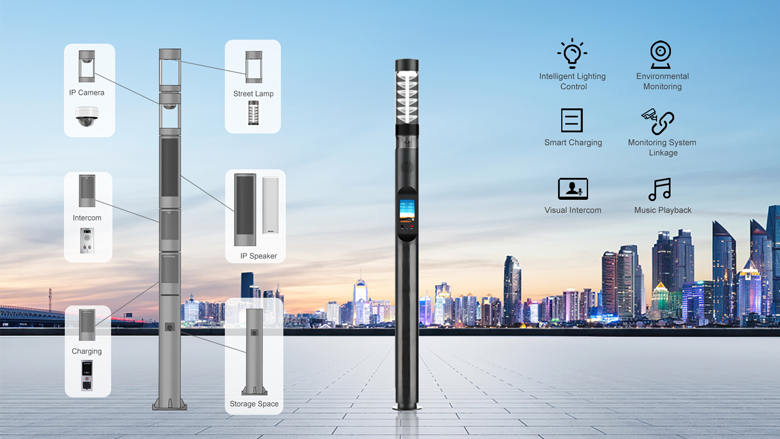

Leave a message

Smart pole systems can utilize their extended sensing and communication equipment to collect various structured and unstructured data. This data is uploaded to a cloud-based public data system via public or private communication networks. The data can be analyzed, classified, processed, and statistically compiled either in the cloud or directly at the edge. Based on the business needs of actual scenarios, data applications are displayed and relevant statistical data is pushed to various government functional departments, providing data support for urban operations and construction.
Smart pole systems consist of components such as the pole body, mounted equipment, controllers, edge computing servers, and remote application platforms. Depending on their functions, the Smart Pole system can be divided into four levels: the IoT sensing layer, the access and aggregation layer, the network transmission layer, and the platform application layer.

The main function of the IoT sensing layer is realized by mounting various devices on the Smart Poles. These devices include smart terminals with microprocessor firmware, non-smart terminals without microprocessor firmware, and pole power supply equipment. This layer mainly supports the basic functions of the Smart Pole system terminals, such as smart lighting, video collection, mobile communication, traffic law enforcement, public broadcasting, environmental monitoring, one-click calling, information dissemination, as well as capabilities like permission settings, parameter settings, data collection, computation, pushing, and ensuring information security for external interfaces.
The access and aggregation layer is responsible for information collection, status monitoring, control strategy management and execution, and data transmission of terminal functional modules of the Smart Pole system. The access and aggregation nodes may have certain edge computing capabilities. Gateways/controllers provide unified access for various terminal devices, aggregate locally collected data, store data, perform protocol conversions, and collaborative processing. The aggregation switch facilitates the communication of terminal devices directly connected to gateways/controllers in a specific area. The edge computing server, as the main computing carrier of the edge data center, supports heterogeneous collaborative computing like CPU/GPU/NPU to meet the key requirements of industrial digitization in agile connection, real-time high concurrency service, data diversity, data optimization, application intelligence, and security and privacy protection.
The primary function of the network transmission layer is to connect terminal devices to the management platform through access and aggregation layer devices (including gateway/controllers, aggregation switches/edge computing servers, etc.), or transmit data to the application platform layer via wired or wireless communication networks. Smart Poles networking can involve a three-layer architecture (indirect connection of terminals to the application platform) or a two-layer architecture (direct connection of terminals to the application platform). Different networking forms (such as tree or star topology) or hybrid networking can be adopted based on different gateway/controller and edge computing server configurations.
The platform application layer is the control and management center of the entire Smart Pole system. It supports multifunctional pole applications and business management, providing data exchange and service connection with other city system platforms.
 【DSPPA Demo】PAVA8000 EN54 Voice Evacuation SystemNovember 12, 2020Abstract: DSPPA PAVA8000 EN54 Voice Evacuation SystemToday, we are gonna show you a demo about our PAVA8000 EN54 Voice Evacuation System.PAVA8000EN54 Voice Evacuation System can not only support manua...view
【DSPPA Demo】PAVA8000 EN54 Voice Evacuation SystemNovember 12, 2020Abstract: DSPPA PAVA8000 EN54 Voice Evacuation SystemToday, we are gonna show you a demo about our PAVA8000 EN54 Voice Evacuation System.PAVA8000EN54 Voice Evacuation System can not only support manua...view The National Standard Approval Meeting held in BeijingJuly 19, 2019The National Standard Approval Meeting held in BeijingThe approval meeting of the National StandardTechnical standard of public address system engineeringis held in Beijing on July 16, 2019. Xue Chang...view
The National Standard Approval Meeting held in BeijingJuly 19, 2019The National Standard Approval Meeting held in BeijingThe approval meeting of the National StandardTechnical standard of public address system engineeringis held in Beijing on July 16, 2019. Xue Chang...view